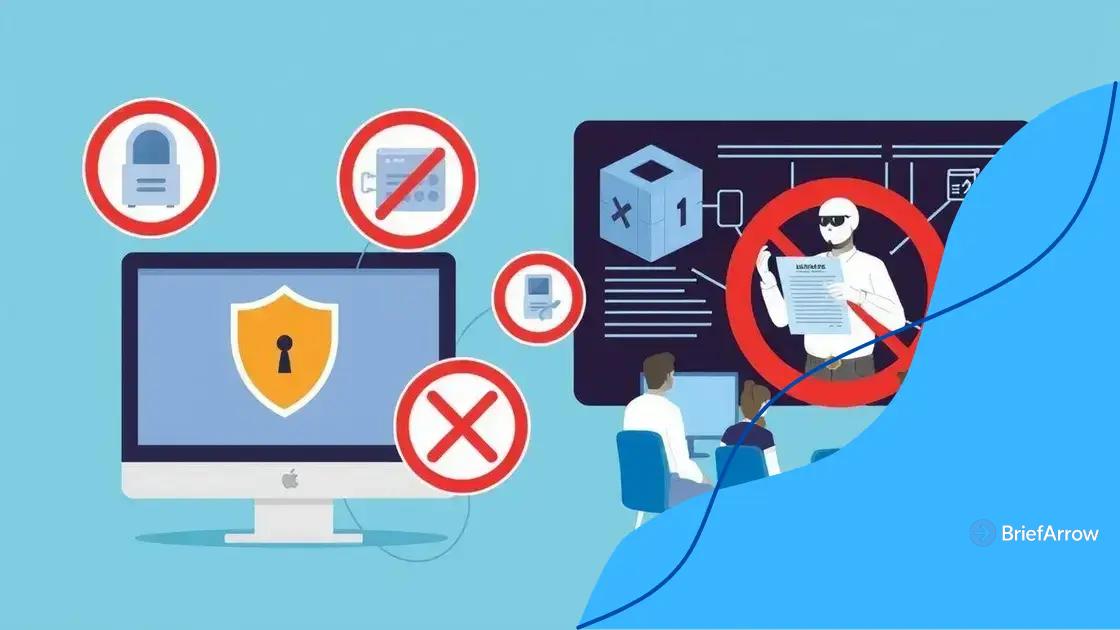Federal warnings about ransomware attacks: what you need to know

Anúncios
Federal warnings about ransomware attacks emphasize the need for vigilance, urging individuals and businesses to adopt strong cybersecurity measures, recognize signs of threats, and utilize federal resources for recovery.
Federal warnings about ransomware attacks are becoming more frequent as threats evolve. Are you prepared for an unexpected cybersecurity incident? Let’s explore how you can safeguard your data and operations.
Anúncios
Understanding ransomware attacks
Understanding ransomware attacks is crucial for anyone using technology today. These attacks can lock users out of their own files and systems, demanding payment for access. Many people may wonder how these attacks work and why they are growing in frequency.
What is a ransomware attack?
A ransomware attack is a type of malicious software that encrypts files, making them inaccessible. Cybercriminals typically demand a ransom to restore access. This can happen to individuals or businesses and can lead to significant disruptions.
How ransomware spreads
Ransomware can infiltrate your system in various ways. Here are some common methods:
Anúncios
- Email attachments or links
- Infected software downloads
- Malicious websites
By understanding these paths, you can better protect yourself.
Types of ransomware
There are different types of ransomware, and each operates differently. Some encrypt specific files, while others attempt to lock the entire system. Knowing the difference can help you respond effectively. Key types include:
- Crypto ransomware: Encrypts files and demands payment.
- Locker ransomware: Locks users out of their devices.
- Scareware: Fake alerts to trick users into paying.
Effective prevention requires understanding these variations. Staying informed can significantly reduce your risk.
Regular updates to security software are essential in the battle against ransomware. When systems stay updated, it can minimize vulnerabilities. Additionally, training employees about safe browsing habits helps in avoiding suspicious downloads.
Protecting valuable data is the primary goal in ransomware prevention. Having backups stored offline is a smart move. In the event of an attack, these backups can keep your data safe.
Signs of a potential ransomware threat
Recognizing the signs of a potential ransomware threat can help prevent a devastating attack. Many users may not know what to look for, leaving them vulnerable.
Common warning signs
Malicious software works quietly, so it’s essential to stay attentive. Some common signs that a system may be under threat include:
- Unusual file extensions that appear suddenly.
- Unexpected alerts or pop-ups demanding payment.
- Files or folders suddenly becoming inaccessible.
If you notice any of these issues, it might indicate an underlying problem.
Unexpected system behavior
Another noteworthy sign of a possible ransomware threat is sudden changes in your computer’s performance or behavior. For instance, if your system starts to slow down or applications take longer to open, it could be a cause for concern.
These changes might come with unfamiliar error messages or system crashes, signaling that something is wrong. Being alert to these signs is crucial for safeguarding your data.
Additionally, be cautious of unusual network activity. If you notice an unfamiliar device connected to the network or strange files being shared, it might point to malicious activity. Regularly reviewing your network connections can help catch these threats early.
Finally, pay attention to any changes in your data. If you find that files are missing or encrypted without explanation, it’s a strong indicator that you could be facing a ransomware attack.
Preventative measures against ransomware

Implementing preventative measures against ransomware is essential in today’s digital landscape. Taking steps to protect your data can help you avoid costly attacks.
Regular software updates
One of the most important measures is to keep all software up to date. Updates often include security patches that protect against vulnerabilities. Neglecting these updates can leave your system open to attacks.
Effective backup solutions
Another vital preventative measure is to maintain regular backups of your data. By storing copies in secure locations, including offline and cloud options, you ensure that you can recover information without paying a ransom. It’s best to automate this process to remain consistent.
Use strong passwords
Using strong, unique passwords for all accounts can significantly reduce the risk of unauthorized access. Passwords should be complex and changed regularly. Tools like password managers can assist in managing multiple passwords effectively.
- Use at least 12 characters.
- Include a mix of letters, numbers, and symbols.
- Avoid using personal information.
Additionally, implementing multi-factor authentication adds another layer of security.
It’s also crucial to educate all employees about phishing attacks. Many ransomware infections begin when someone unknowingly clicks on a malicious link. Training sessions can improve awareness and preparedness.
Finally, ensuring a strong cybersecurity framework within an organization should include regular security assessments. These assessments help identify weaknesses in systems and processes, enhancing overall resilience against ransomware threats.
Steps to take if attacked by ransomware
If you find yourself facing a ransomware attack, knowing the steps to take if attacked by ransomware is critical to minimizing damage. Acting quickly can make all the difference in recovering your files.
Stay Calm and Assess the Situation
The first step is to remain calm. Panicking can lead to hasty decisions. Assess the situation to understand the extent of the attack. Identify which files are affected and whether the ransomware is still actively encrypting more files.
Disconnect from the Network
Immediately disconnect your device from the internet and any network it’s connected to. This will help prevent the ransomware from spreading to other devices and mitigate further damage.
Do Not Pay the Ransom
If you receive a ransom note, do not pay it! Paying does not guarantee the return of your files and can encourage further criminal activity. It’s essential to explore other recovery options first.
Instead, take note of the ransom demand details. This information can be valuable if you decide to report the incident.
Contact IT or Cybersecurity Professionals
If you have an IT department or access to cybersecurity professionals, contact them right away. They can help evaluate the situation and provide guidance on the next steps. Experts may use tools to remove the ransomware and recover encrypted files.
- Do not attempt to remove the ransomware yourself.
- Avoid reboots that may complicate recovery efforts.
- Document all actions taken for future reference.
Moreover, consider reporting the attack to local law enforcement. Providing them with details can aid in their investigations into ransomware crime trends.
Finally, once the immediate crisis is managed, take steps to secure your systems. Regular backups and updated security software will be vital in preventing future attacks.
Federal resources for ransomware recovery
Utilizing federal resources for ransomware recovery can be essential for businesses and individuals hit by these attacks. The U.S. government offers various assistance programs and guidelines to help recover from a ransomware incident.
Federal Bureau of Investigation (FBI)
The FBI is a key resource when dealing with ransomware. They provide guidance on how to respond to attacks and encourage reporting incidents. By contacting the FBI, victims can gain insights into available recovery processes and support. They also maintain a comprehensive database on ransomware trends, helping to improve prevention strategies.
Cybersecurity & Infrastructure Security Agency (CISA)
CISA offers numerous services aimed at enhancing cybersecurity resilience. They provide resources such as:
- Cyber hygiene services to identify vulnerabilities.
- Incident response assistance for affected organizations.
- Reporting guidelines to share incidents with relevant authorities.
Accessing these resources can aid in understanding the attack and protecting against future threats.
Federal Trade Commission (FTC)
The FTC also plays a role by educating consumers and businesses about ransomware. Their website hosts valuable information regarding prevention and recovery. They recommend reporting ransomware incidents to help combat cybercrime.
Additionally, the FTC provides tools for creating a data breach response plan, which is vital for recovery efforts. This preparedness can significantly minimize the impact of an attack.
Victims can also tap into local law enforcement resources, as many collaborate with federal agencies to address cyber threats. Involving both local and federal authorities increases the chances of recovering assets and gaining valuable cybersecurity advice.
FAQ – Frequently Asked Questions about Ransomware Recovery
What should I do first if I suspect a ransomware attack?
If you suspect a ransomware attack, the first step is to disconnect the affected device from the network to prevent further spread.
Is it advisable to pay the ransom to recover my files?
No, paying the ransom does not guarantee that you will get your files back and may encourage further attacks.
Where can I find federal resources for ransomware recovery?
Federal resources can be found through agencies like the FBI, CISA, and the FTC, which offer guidance and support for recovery.
How can I prevent ransomware attacks in the future?
You can prevent ransomware attacks by keeping software updated, using strong passwords, backing up data regularly, and educating users about phishing.